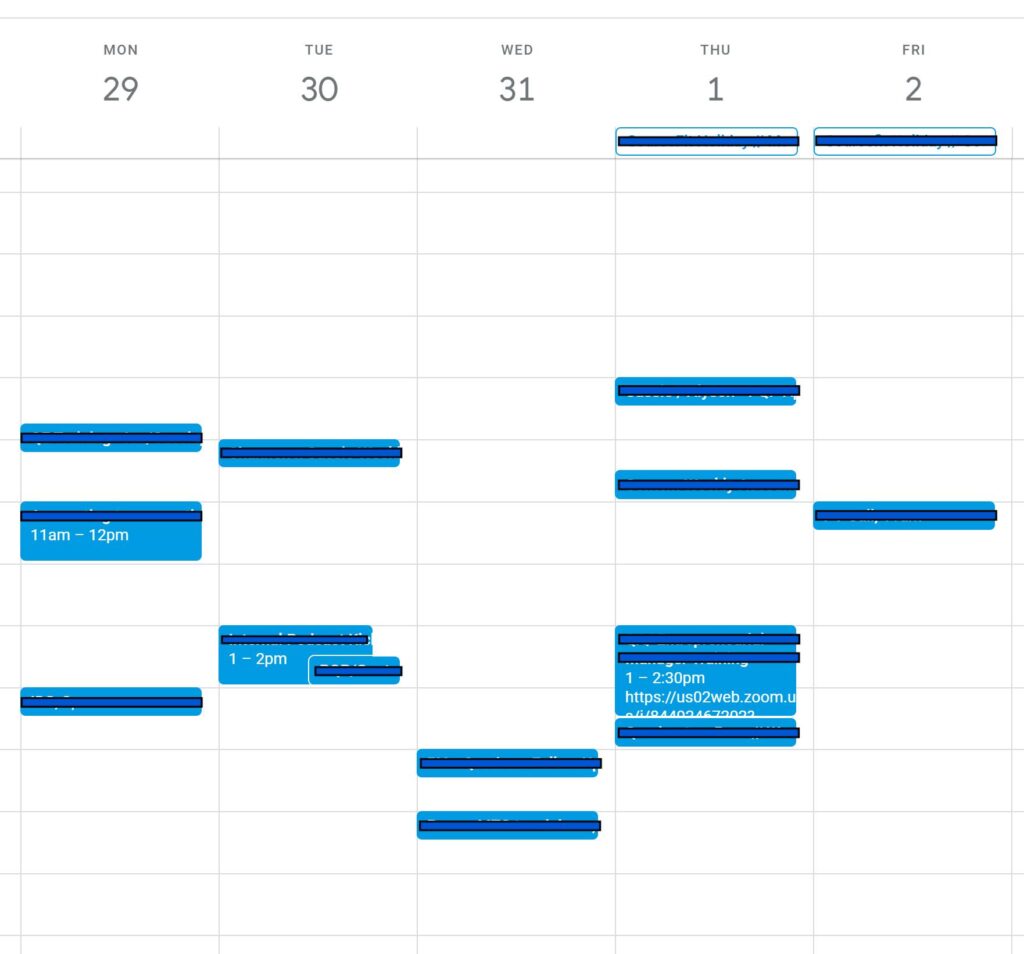The only truly scarce resource is human time.
I made tons of mistakes when I started my first company, especially about managing my time.
My pervading belief: “Ah, I’m free from the clutches of corporate life! I can live on my own terms and use my time however I want!” (Well yes, but that was always the case.)
Without the invisible systems and rituals of employment as a fail safe, I fell into some harmful traps.
- I didn’t set and achieve goals proactively
- I didn’t prioritize what was important
- I didn’t focus on relationships
- I didn’t care for my body or mental health
- I didn’t believe friendships or time-off were as important as business growth
- I never relaxed and thought that “always on” was a better way to live.
As a result, the business was hampered because I wasn’t showing up at my best. And, life was kind of miserable.
So, I made a lot of changes. Here’s everything I learned about time management in a near-decade of entrepreneurship.
Check your mindset
One harmful recurring thought pattern is: “I never have enough time.” Like money, we “spend” our time. And, once spent, we never get it back.
A better thought pattern: think of time as an investment, not as an expense.
Intentionally investing your time today can creates more time in the future, compounding time back on your schedule, every week.
The reframe: “Where can I invest time?”
Another common founder thought pattern: “I need to sacrifice myself, my health, my relationships for the business.”
The truth: “By sacrificing myself, my health, my relationships, the business will never work.”
So, put your own oxygen mask on first. That’s what they say on the plane.
By serving yourself first, you set up a foundation to better lead and serve others.
Else, you’re racing to some externality—like your future liquidity event—to start living the life you want.
Why not enjoy the journey today?
Visualize your time
Knowing how you spend your time today is a key to driving change.
Imagine an investor spending their capital—but they don’t know where, how, or with who. How will they ever collect a return on their investment?
The issue is that most people don’t know where or how they spend their time each day—it’s a data visibility issue.
Look at your calendar last week. Does it look like A or B?

Typical reactions I hear to the second calendar:
- “That looks REALLY busy; I don’t want to be that busy!”
- “I don’t want an hour by hour schedule of my day.”
We’re conditioned to look at our calendar as a source of “busyness.” When our calendar is full, it feels busy. When it’s empty, it feels open.
The shift? You are already using your time somewhere, somehow. You just can’t see it.
Were we to visualize the time of every person on the planet, it would look like the second calendar.
Invisible means no data and no accountability to yourself. Visible means facing the truth of how we’re actually spending our most precious resource.
Similar to taking a fine-tooth comb to your personal finances, you may not like what you see, and the ugliness of it may shock or surprise you. That’s okay. Embrace it. Knowing the truth puts you far ahead of the crowd—and gives you an opportunity to change what no longer serves you.
Accept your rhythms
The “best” schedule is the one that works well for you. This requires you to be honest with yourself in how you’re wired.
For years, I read things like “the 20 routines of top executives” and “the 8 things these CEOs do every day” articles. Hot. Garbage.
False belief: “If I do these things, then I’ll be a top executive or great CEO.”
The truth: “These people figured out what works well for them.”
This is a process of self-discovery. Every human follows a natural circadian rhythm mostly rooted in our genetics. It’s inherited from our parents. Yes, you can shift it, but it’s better if you start by accepting it.
The majority of our population are “third-birds.” Not night owls, not early birds.
I am a third-bird. I wake up around 7:30a and start my work between 9-10a. I’m at my highest energy between 10a-1p, so that’s where I do my most challenging or creative work. (It’s 9:32a as I write this line—creative work!)
Integrate planning and execution
I know what I plan to do basically every hour of my work day—with lots of open spontaneous space on evenings and weekends.
Some may be turned off by this idea: “I don’t want to be planned and scheduled every waking moment!”
You have a choice.
You can choose to create a plan, put it into action, and adjust as you go. Or, you can let the day’s events dictate how and where you place your efforts.
I practice this by translating my highest priority goals into discrete blocks of time onto my calendar. I take a guess at how long it will take me, and I create a “meeting with myself” to work on it.
Planning is exercising your skills in thinking ahead. At first, you’re not going to get it right. After years of practice, it still isn’t “perfect.” It’ll never be “perfect.” It’s a flexible, human process and framework for thinking. Show me a person that lives their schedule to the tee, every day, and I’ll show you a person imprisoned in a system of their own design.
You want to know what you’re doing ahead of time, but not so rigidly as to ignore other signals necessitating a pivot away from the plan. You may not feel top notch every day. A truly urgent priority may appear.
So, be kind to yourself. Give yourself permission to shift.
Need to reprioritize? Simply move the block of time somewhere else.
Underestimated the time? That’s okay. Learn from it and adjust for next time.
“Are you free for a quick phone call?” No, I’m working on my highest priority work.
Take action
- Here’s a quick guide to help you get started with this methodology.
- Flip your calendar back to last week. Create a full 24/7 visible schedule on how you used your time.
- Take the AutoMEQ (Automated Morningness-Eveningness Questionnaire) to discover your natural sleep habits.
- Write out your ideal week, hour by hour, day by day, from waking to sleeping, for one work-week. Pay attention to your high energy levels from the AutoMEQ.
- Schedule a “meeting with yourself” at your highest energy levels to focus on your most challenging or creative work.
Some tips for the road:
- Clarify your top goals. Write these down and remind yourself daily. I use a whiteboard hanging in my office. Proactively block off time to execute on these goals. Else, it’s likely they won’t happen.
- Prioritize your health and relationships. Anything else is unsustainable. It’s only a matter of time. Put them on the calendar.
- Check your data sources. Look at your sent email folder, your completed to-do list, your phone call log, and your Oura/Fitbit/WHOOP to figure out how you’re actually using your time.
- Set boundaries. Communicate your new schedule to set expectations about the change. This includes clients.
- Define your interruptions. Allow only your highest priorities, and what’s truly urgent, to break your plan. Challenge yourself to define what “truly urgent” means. It’s likely most things aren’t.
- Block off more time than you think you need. You’re more likely to underestimate the time things take, rather than overestimate.
- Add color. Use color-coding on your calendar to visually break up your time. One simple paradigm: one color for meetings, one color for deep work, one color for breaks/meals.
- Batch like-tasks at nearby times of day. Put all your meetings in the afternoons, or one dedicated time to respond to all your chat notifications and return phone calls.
- Turn off notifications. Consider which apps, channels, notifications truly require a response now versus batched.
- Remove unnecessary Slack channels. It’s likely you don’t need to be involved in every channel for everything.
- Set up recurring meetings with your team. This is primarily for connecting, human to human. It’s also a great container to funnel questions that normally would interrupt you in a Slack message or ad-hoc phone call. Almost everything imaginable isn’t “urgent” and can wait.
- Shift more to async. Many ad-hoc meetings can turn into emails, messages, or Loom videos. Batch and ship them.
- Create office hours. Dedicate a time for anyone on your team to book extra time with you. This works great for teams where you are the “expert” and your role is to train the team.
Reflect on your results
Many of these structures exist for us when we’re employed. But when we’re building something new, it’s up to us to create these for ourselves.
After a few weeks, you’ll get the hang of it. But is it “working?”
The truth is in your answer to these questions:
- Am I (and is my team) working more on the right priorities—and less on the work that doesn’t matter?
- Is the business growing? Are we seizing the right opportunities?
- Do I feel happier, healthier, and more energized?
- Are my relationships outside of my work flourishing?
I’ve practiced everything above for years, and as a result:
- I know my goals and proactively work on them daily.
- I care more for my body and mind—giving them the rest and recovery they need to perform at their best.
- I invest in relationships and “downtime.”
- The boundaries between “work Chase” and “real Chase” have faded.
This creates a flywheel that compounds over time.
More energy → More traction on real priorities → More business growth → More resources (cash, people, systems, partners, etc.) → More horsepower (to delegate) → More energy
A richer life
We are humans. We are not productivity machines. None of us want to be tired, burned out, and overwhelmed in our work. The goal is not to squeeze the juice out of every hour of the day. The goal is to maximize our energy to bring out our best selves. This is about giving ourselves permission to simultaneously achieve great business outcomes—while keeping our peace. Productivity is out. Wellbeing is in
Love what you’re reading? Subscribe to our newsletter and never miss out on our latest posts.







